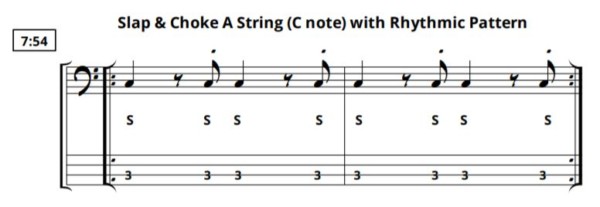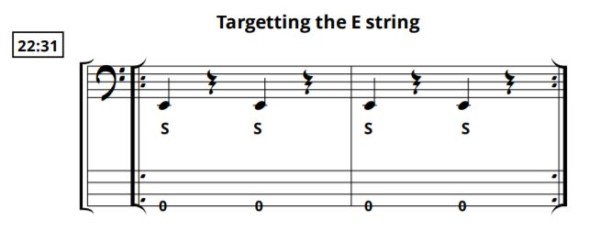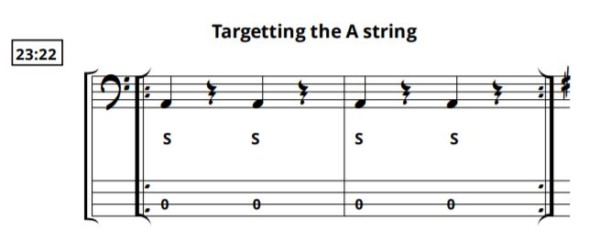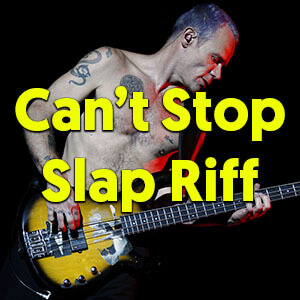This lesson deals with cleaning up your slap technique. I’ve taught slap bass to many students and the most popular problem tends to be a lack of control over muting and accuracy of the thumb.
Here I try to get around this problem by changing your perspective. You should think of muting and silence first and the notes come second to that. This is achieved by using what I consider a home position. Check it out!
Silence That Noise
When I teach anyone slap, probably the biggest problem is unwanted noise. The thumb position we use for slap bass means that you can’t use your thumb and fingers to mute other strings and notes in the same way as when you’re plucking. This means it’s all too easy to end up with loads of unwanted notes in your playing (sometimes not even notes – just clanking noises).
So these exercises are designed to help you hit only the notes you want to hit so your slap basslines are nice and crisp.
Exercise #1
First, just play a C on the the third fret of the A string. The key is to rest all four of your fingers across all of the strings to deaden them from the impact of any wayward strikes. I call this a “home position” for slap. The real trick is to be very relaxed – you don’t want to press down on the strings, otherwise if you do strike the wrong string, you’ll get either a harmonic or an actual note – which very likely would be out of key.
When you come to strike the C, lift three of your fingers up at the same time as you strike the A string, while at the same time pressing down on the C note. This has to be done in a single movement. You don’t want to lift, press, then strike: all three actions should take part at the same time.
Speed is irrelevant at this point. We’re only interested in getting that technique down and getting a single clean note. And, of course, you want a clean end to the note too. To do that, simply put your fingers back across the string in the home position and you’ll naturally mute the string.

Exercise #2
Very similar to exercise 1, but we’re playing a G on the third fret of the E string. For muting on the E string, you might find it easier to mute across the other strings with just your fretting finger rather than having to lay your whole hand across the strings. It’s very much a question of personal preference though.

Exercise #3
Obviously in real life, most basslines involve more than one note on one string! In this exercise we simply hit on the quarter notes (i.e. four beats in a bar – the speed doesn’t matter: play at whatever tempo you’re comfortable with). A G then an an A on the E string (third and fifth frets) than a C and D on the A string (third and fifth frets), then back down.
These kinds of simple scalar movements are the basis of most lines.

Exercise #4
This is essentially the same as exercise one, but with more rhythmic interest. Instead of merely hitting on the quarter note, we are breaking the line up to hit in different places. This is where slapping works so well in a funk context, as it helps to create the syncopated feel of the style.

Exercise #5
And, like exercise 4, the same rhythmic pattern but playing a G (third fret on the E string)

Exercise #6
And a similar rhythm through a simply chord change of C, F and G – so the third fret of the A string, the first fret of the E string, and the third fret of the E string. Don’t forget: this isn’t about speed – all we’re looking for is to get comfortable with the muted of the notes and a clean slap for each note.

Exercise #7
Open strings present their own challenges, as it is very easy to hit other strings and create the noises and clanking that we’re trying to avoid. As with all notes though, the principle is the same: holding down the strings before you hit the string, releasing the E at the moment you strike with the thumb, and choking it off immediately afterwards to give a single, clean percussive note.

Exercise #8
One thing I constantly tell people is to hit lighter and more accurately. Many people see famous slap bassists such as the Red Hot Chili Peppers’ Flea and assume that slap is about aggression. You’re more than welcome to develop an aggressive style, but really you should build towards it from solid foundations based on accuracy. In this first exercise, we’ll work at targeting a specific string: in this case, the open E.

Exercise #9
And, of course, we want to do the same with the A string. What we are working towards is a kind of muscle memory for where to position our fingers and hands when we know which string we are going to slap. This will develop independence, accuracy and – ultimately – speed.

Exercise #10
And finally we bring together all the things we’ve learned to play through the G Major scale. As with all these exercises, start slowly and remember that we’re aiming for accuracy and clarity in our playing ahead of speed. Speed will come with time!
















Mark Smith’s instruction course is so very, very good. His technique to approaching one of the many groovy riffs is beautiful. It’s so understandable. Easy to follow. And when it comes to music theory, Mark’s layout of arpeggio’s, scales & modes etc., are so very clear.
I have been plucking on my bass, since I was a kid back in the late 50’s. I grew up with the Smothers brothers, early Ed Sullivan, English Invasion, 60’s, 70’s, until now. A 14 yr. stretch on 6 string as Worship leader in a local church. Anyway, now I’m 64 & I have a GREAT desire to relearn my Bass. Upon searching the internet, I bumped into Mark’s “Talkingbass.net”. I’m learning so much more than I ever knew. What a blast ! Hey . . . no more plucking, NOW I’M PLAYING ! Thanx Mark. And to the whole Talking Bass Team”
If I had come across this lesson years ago, I would have saved myself long hours of frustration and pointless practice. Thanks so much for your great material. You explain subtle concepts in a way that enables me, a non gifted player, overcome my obstacles. BTW, I just realised that I bought your scales book exactly one year ago; I’ve read many books on that matter and yours is clearly the best. Thank you again.
I wasted so much time back when computers where not available trying to learn how to play bass correctly.
Now we have all that we do and a certain type music is popular, no bass, no guitar , wow this generation got ripped off, I hear guys trying to play computer game music .
What we hear at the age of 14 inspires us for the rest of our life and I use to listen to Rock ‘n Roll.
But that error is over and Jazz is my thing now. At 58 its what I like the most, Marcus Miller type music.
Brilliant…. Needed a slap clean up… But didnt know how to go about it. Thought it was all in the thumb, but that’s only part of it… Some very practical wisdom here. Thanks again.
Great lesson man. You break it down so anyone can understand it.
Hey Mark, with a 20-year in love with my nylon strings classical guitars, and billions of music/guitar/bass related web pages, I can say:
This is THE BEST bass learning related internet source!
Great THANK YOU ;)
Love your lessons Mark. Very understandable and easy to follow. Keep up the good work.